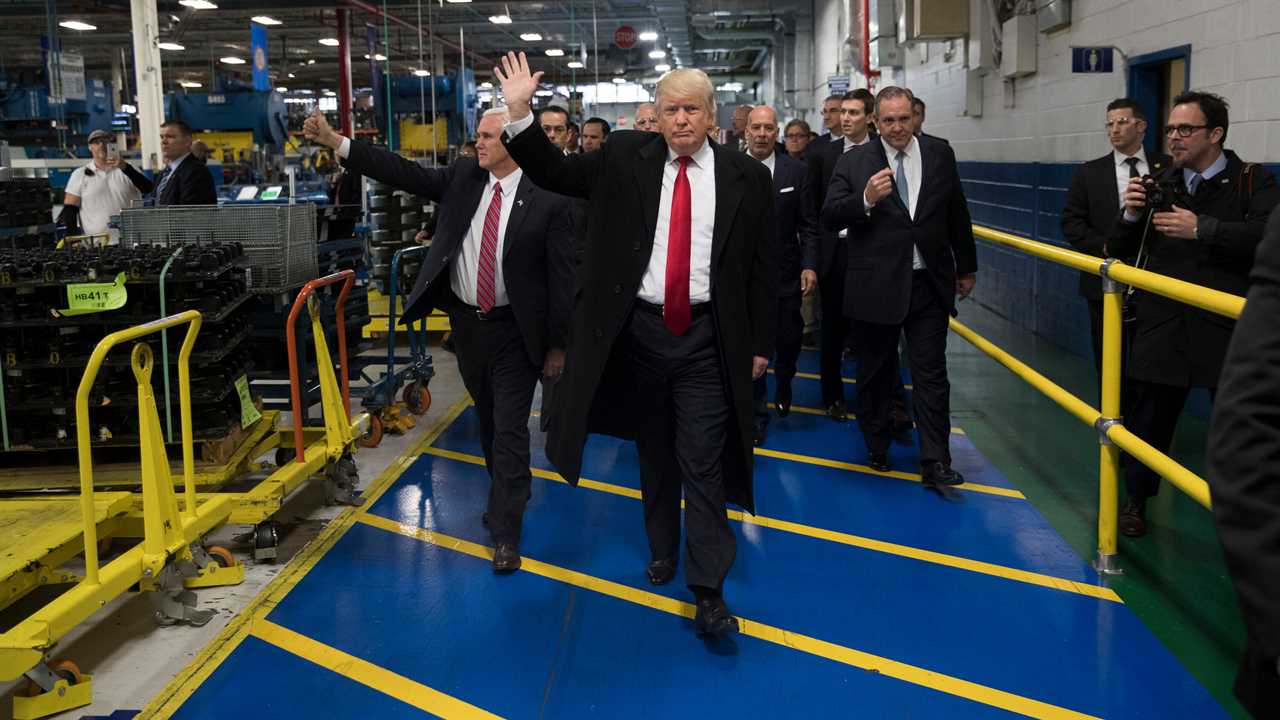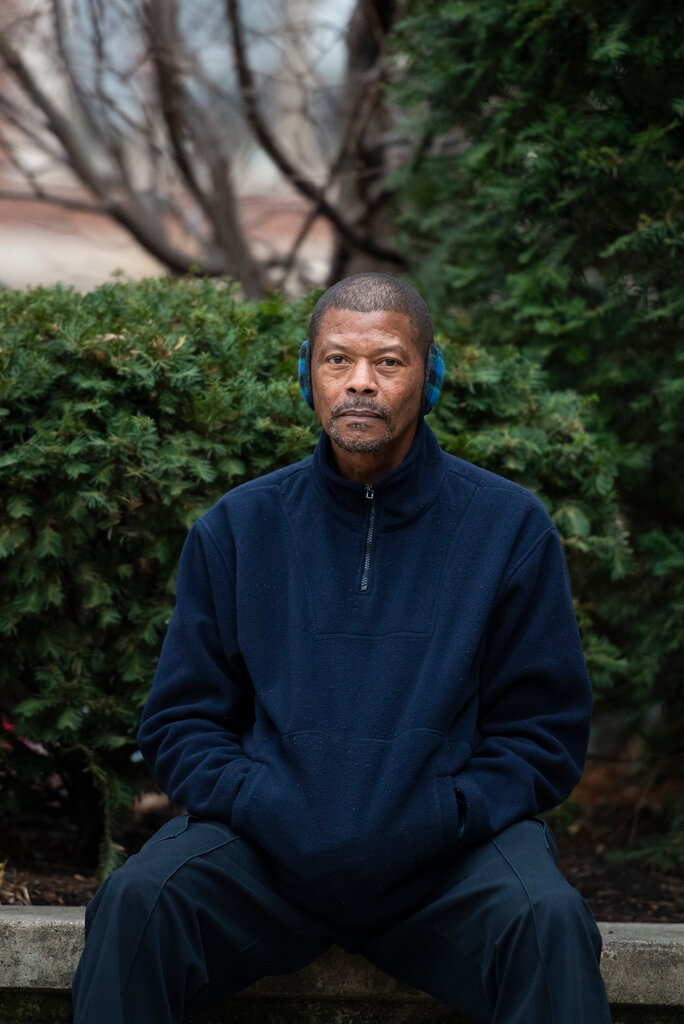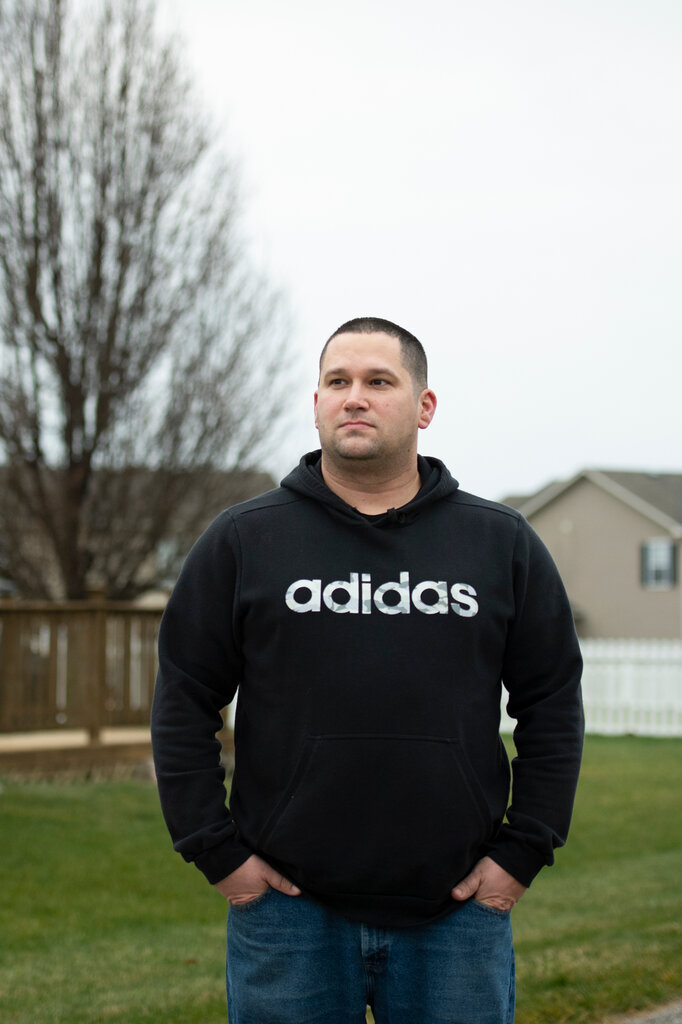
For the workers fortunate enough to remain employed at Carrier’s Indianapolis factory, which Donald Trump singled out as a symbol of American manufacturing distress in 2016, these should be the best of times. The assembly line is churning out furnaces seven days a week, overtime is abundant, and shares of Carrier are soaring even as Covid-19 ravages the overall economy.
But that’s not how Anthony Cushingberry, a 24-year veteran of the factory floor and a union steward, sees it. “The trust left a long time ago,” he said recently after completing a 10-hour shift as a materials associate, taking deliveries of parts and shipping out scrap. “Some of us think they are stockpiling equipment so they can close the factory later.”
That’s a worry that has only intensified for workers like Paul Roell, a Trump supporter who fears that after the president leaves office, Carrier management will dust off old plans to move the factory’s 1,050 jobs to Mexico.
“Trump is the reason we have our job, and as long as he was in office, we were safe,” Mr. Roell said. “We don’t have the leverage anymore.”
That is open to debate, but it’s clear that without Mr. Trump’s intervention even before he took office, the factory would never have become so prominent, if it had survived at all.
The furnace-maker’s turn in the spotlight began in February 2016 with a 3-minute-32-second video of a Carrier executive announcing that the factory would be closed, with production shifting to a facility near Monterrey, Mexico. Workers in Indianapolis make more in an hour than their colleagues in Mexico do in a day.
“This is strictly a business decision,” the executive told the booing, cursing workers before telling them to quiet down. Mr. Trump soon warned on Twitter that as president he would force Carrier, then part of the conglomerate United Technologies, to reverse its decision.

Credit...Lee Klafczynski for The New York Times
“The trust left a long time ago.”
Anthony Cushingberry
It didn’t take that long. Less than a month after his victory, Mr. Trump and Vice President-elect Mike Pence, Indiana’s governor at the time, worked out a deal with the company to keep the factory open. In exchange for $7 million in state tax breaks, Carrier would preserve about 700 blue-collar jobs, while laying off 632 workers.
Since then, the 2016 deal itself has become a political Rorschach test. The loss of nearly half the positions, plus the tax incentives that United Technologies received, underscored the limits of Mr. Trump’s powers to save jobs, even as his supporters hailed his role in keeping the plant open at all.
The factory has managed to hang on since then and even prosper. But even relatively well-paid blue-collar workers don’t feel secure. The real winnings have gone to Carrier shareholders, whose shares have more than tripled since the company was spun out of United Technologies in April.
And now, with Mr. Trump about to leave the White House, the factory is at a turning point. It is operating seven days a week, with mandatory overtime for workers. Carrier has been hiring, adding some 300 workers and bringing the total work force to nearly 1,050.
The hiring has helped morale improve since it bottomed out in 2018 with rising absenteeism and machine breakdowns. “I still go in and keep on pushing every day,” said Robin Maynard, who manages 13 to 15 workers as a group leader and is looking forward to retiring in two years.
New hires have helped offset absenteeism, Mr. Maynard said, but not all of the newcomers could handle the job and were quickly let go. “They just weren’t factory material,” he said.
James Adcock, an official with the United Steelworkers, which represents the Carrier workers, said there was hiring every week. “We’re not quite where we were in 2016,” he said, “but we are working toward that.”
And for those who can handle the pace, the Indianapolis plant offers a shot at a solidly middle-class lifestyle, with wages of more than $20 an hour, with time-and-a-half pay on Saturdays and double-time on Sundays.
“Financially, it’s good,” Mr. Cushingberry allowed, noting that some workers are making more than $80,000 a year. By contrast, the warehouses and logistics centers that are hiring nearby pay much less, in the range of $15 an hour. But many workers say they can’t handle the pace, however rich the rewards.
Latest Updates
- The Washington Post has 3 million digital subscribers.
- Coinbase, a top cryptocurrency company, files for initial public offering.
- Amazon wrongfully fired a worker in retaliation for organizing, a labor agency says.
“You feel worked to death,” said Rod Smith, a 17-year veteran. “When you work 30 days straight, where is the light at the end of the tunnel?” Despite the recent additions to the work force, Mr. Smith feels Carrier should be hiring more aggressively, rather than working its existing employees so hard.
“The company is trying to run it light to cut costs on manpower,” he said. Carrier declined to comment for this article, but the company recently raised its target for annual cost savings to $700 million from $600 million, and the pressure to find new efficiencies is intense.
Mr. Roell, a member of the Indiana National Guard, said the days he has to don his uniform and report for Guard duty are a welcome respite from the assembly line. “It’s not a vacation, but there’s more downtime,” he said.
Employees were idled for several weeks in the spring after the coronavirus pandemic first struck, but they were soon classified as essential workers and went back to work. One employee died of Covid-19, and Carrier has adjusted production lines to create more space between employees while requiring masks and checking temperatures as people arrive for the day.
To thank them for working through the pandemic in the spring, the company gave a party in a tent in June “with a chicken lunch and a pack of Life Savers as thanks,” Mr. Roell recalled, while other local employers gave bonuses and raises.
At the same time, Carrier has made an unlikely emergence as a stock-market darling. Long a dull if steady performer overshadowed by the military business within United Technologies, it was spun out as an independent company in early April.
The timing couldn’t have been worse — it was the depth of the recession caused by the coronavirus outbreak — and Carrier’s shares made their debut at $12. But a booming housing market, driven by low interest rates, has powered demand for new heating and air conditioning systems, said Deane M. Dray, an analyst with RBC Capital Markets.
So has a desire by Americans suddenly stuck at home to upgrade their ventilation systems, Mr. Dray said. Demand for Carrier’s residential heating and cooling systems rose 46 percent in the third quarter, and the company raised its full-year sales and profit forecast when it reported earnings in late October.
“There’s a silver lining to working from home — it means work the home,” Mr. Dray said. Carrier now trades around $38 a share, and Mr. Dray sees a further opportunity for the company as the new Covid vaccines are rolled out.
The two leading vaccines need to be refrigerated well below freezing, which could drive demand for cooling systems worldwide. That, plus Carrier’s new freedom to maneuver as an independent company, bodes well for shareholders.
“At United Technologies, Carrier was not a priority for growth capital,” Mr. Dray said. “They are finally in control of their own destiny.”
The same cannot be said of workers like Mr. Smith, Mr. Roell or Mr. Cushingberry. And while the saga of Carrier’s Indianapolis factory is well known in political circles, it hasn’t even come up on earnings calls or otherwise registered for the analysts who cover Carrier on Wall Street. “This is below the radar screen for us,” Mr. Dray said.

Credit...Lee Klafczynski for The New York Times
“Trump is the reason we have our job, and as long as he was in office, we were safe.”
Paul Roell
Carrier workers who held United Technologies shares in their retirement accounts received stock as part of the offering, but didn’t receive shares outright or otherwise take part in the spinoff. Carrier’s chief executive, David Gitlin, owns more than 200,000 shares, worth nearly $8 million.
“It’s once in a lifetime, but it was a missed opportunity,” said Corey Austin, a Carrier employee who has worked on the assembly line for 17 years. But Mr. Austin, who earns $23.87 an hour, has no illusions about how lucky he is to still be employed at Carrier.
His father and mother spent decades as assembly workers and United Steelworkers members at Diamond Chain, a factory in downtown Indianapolis that announced this year that it would close after operating for more than a century.
Negotiations on a new contract at Carrier begin next year, and Mr. Austin hopes to see a raise when the new contract goes into effect. “Employees didn’t even know the spinoff was happening,” he said. “And a lot of employees don’t trust what management tells them. People are just in the mind-set of working every day.”
In the past, new contracts have typically increased salaries by 50 cents an hour each year over three years.
With or without Mr. Trump in office, Mr. Roell has no plans to look for a job anywhere else, despite his anxiety about the factory’s long-term prospects. In the meantime, he doesn’t foresee a break until Christmas Eve, and the last full day he was able to spend with his family was on Thanksgiving weekend.
But with a salary of $25.96 an hour — and two children to put through college — the long hours and constant uncertainty are worth it. “It’s a pretty big worry,” he said. “I just turned 40, and I’m going to keep working there. Hopefully, they will stick around.”






